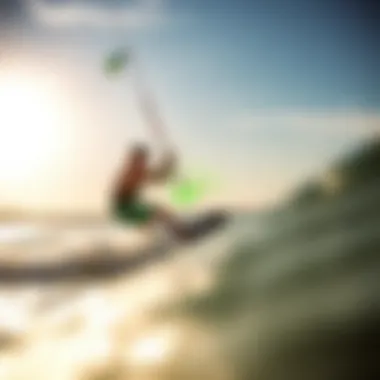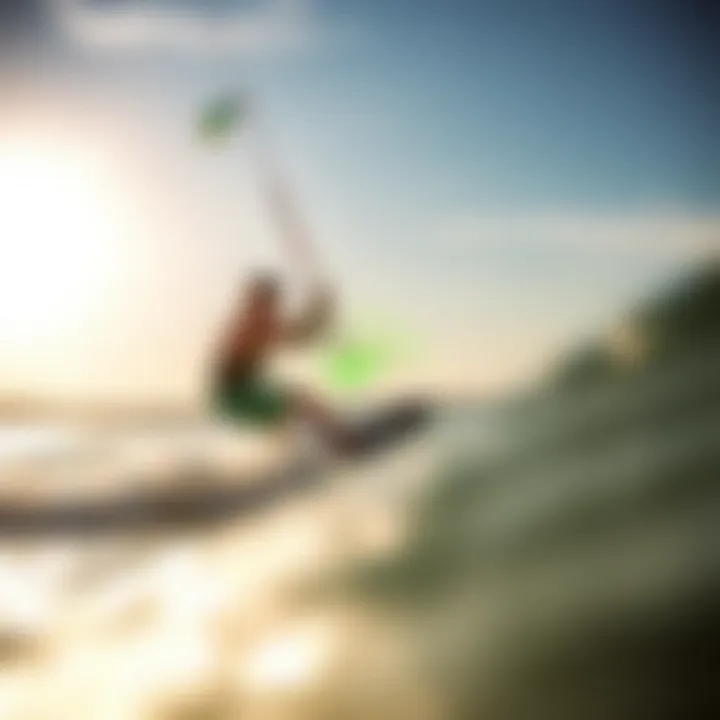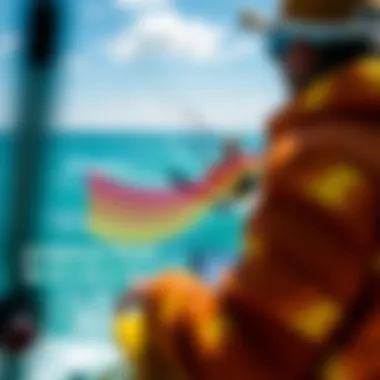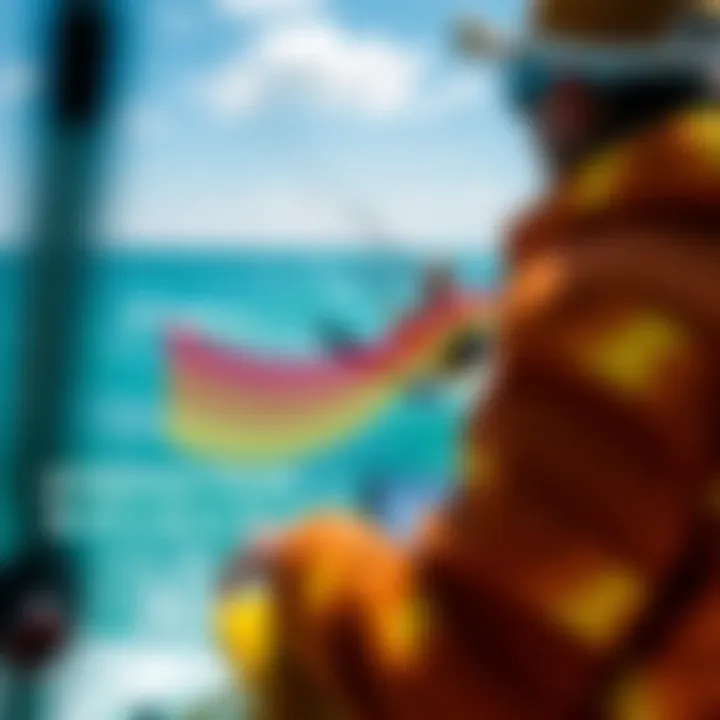Understanding National Weather Radar for Kiteboarding in Destin


Intro
Destin, Florida, is a vibrant hub for kiteboarding, attracting enthusiasts from all over. The area’s pristine waters and favorable wind conditions make it particularly appealing, but the weather can be unpredictable. Kiteboarders need to be well-informed when it comes to local weather patterns. This is where national weather radar comes into play, providing critical data that helps kiteboarders make safe decisions. By harnessing the capabilities of radar technology, riders can enhance their experience and minimize risks.
Understanding the intricacies of weather patterns is essential for navigting the waves without a hitch. This article delves into the role national weather radar plays in kiteboarding, exploring how it can aid both seasoned pros and beginners alike.
As we dig into the details, we will cover how radar technology operates, discuss the meteorological data accessible to kiteboarders, and offer practical insights on how to leverage this information for an improved kiteboarding adventure.
Gear Insights
When approaching kiteboarding, the right gear can make a world of difference. Below, we explore crucial gear aspects one should consider.
Latest Gear Reviews
Kiteboarding technology evolves rapidly. Brands like Duotone, Naish, and Slingshot consistently put out new equipment designed to enhance performance. Recent reviews on Kiteboarding Magazine highlight the new Duotone Rebel 2023, which promises better performance in gusty conditions. Its stability and responsiveness are well-rated by users, making it a top contender in the kite community.
Another product worth considering is the Naish Pivot, renowned for its versatility, whether the wind is powerful or light. The kite features an improved canopy design, allowing for precision in transitions and jumps.
Essential Gear for Beginners
For those just starting their kiteboarding journey, choosing the right gear is fundamental. Consider these essentials:
- Kite: Look for a beginner-friendly option, such as the Cabrinha Switchblade. It offers great stability for novice kiters.
- Board: A lightweight board like the Liquid Force Drive can help you gain confidence.
- Harness: A comfortable harness like the Mystic Warrior supports long sessions, crucial for any adventurer.
- Safety Equipment: Never skimp on safety. A helmet and impact vest are must-haves.
With the right gear, you can truly enjoy what kiteboarding has to offer.
Techniques and Tips
The world of kiteboarding is as much about skill as it is about technology. Without the right techniques, even the best gear won't help. Here, we break down some essential aspects.
Advanced Tricks and Techniques
Once you're comfortable on the board, you might want to try out some advanced tricks. Moves like the Backroll or Kiteloop can elevate your kiteboarding game. Start by breaking these tricks into smaller components and practicing them separately.
Mastering your landing technique is also vital; it can mean the difference between a smooth ride and a nasty fall.
Safety Practices for Kiteboarders
Safety cannot be overstated in kiteboarding. Here are some tips to keep in mind:
- Always Check the Weather: Utilize national weather radar effectively to assess wind patterns and potential storms.
- Buddy System: Never kite alone, no matter your skill level.
- Know Your Limits: If wind conditions seem too tough, it’s best to sit it out.
- Pre-Flight Checks: Before heading out, ensure all your gear is in working order. Faulty equipment can jeopardize your safety.
> Proper use of national weather radar can significantly improve your kiteboarding experience. Staying informed about changing weather conditions can enhance both safety and enjoyment on the water.
As you navigate the thrilling aspects of kiteboarding in Destin, keeping abreast of weather conditions through national radar can empower your decisions. The right tools and techniques hand-in-hand ensure not only excitement but also safety while gliding across the beautiful waters.
Prolusion to Weather Radar Technology
Weather radar technology plays a pivotal role in how we understand and predict atmospheric conditions. In the context of kiteboarding in Destin, Florida, harnessing this technology is not simply beneficial; it's crucial for ensuring safety and maximizing the enjoyment of the sport. Kiteboarders, whether novices or pros, heavily depend on accurate and real-time weather data to make informed choices regarding their activity. This section delves into the essence of weather radar, elucidating its functions, advantages, and the nuances that make it indispensable for outdoor enthusiasts.
Overview of Weather Radar
Weather radar operates as a powerful tool that provides insights into various meteorological phenomena. At its core, this technology employs radio waves to detect precipitation, measure its intensity, and even monitor wind patterns. In Destin, a region known for its dynamic coastal weather, these capabilities become invaluable.
- Precipitation Detection: By emitting radio waves and analyzing the signal that returns after hitting raindrops or water droplets, weather radar can ascertain where it’s raining and how hard. This allows kiteboarders to steer clear from stormy areas.
- Wind Profiling: The radar can also help determine wind speeds and directions, critical for kiteboarding as wind plays a central role in performance and safety.
- Severe Weather Alerts: It holds the potential to warn users about severe weather events, such as thunderstorms or shifting wind patterns that could jeopardize a safe kiteboarding experience.
Overall, this technology provides kiteboarders with timely and useful information, allowing them to plan their outings effectively.
The Science Behind Radar


Understanding the science that powers weather radar can further illuminate its value. The fundamental principle lies in the reflection of radio waves. Here's a simplified breakdown:
- Radio Wave Emission: A radar system emits a burst of radio waves directed into the atmosphere.
- Reflection: When these waves encounter precipitation or other atmospheric particles, they bounce back to the radar device.
- Data Interpretation: The time it takes for the waves to return and the strength of the returned signal help meteorologists gauge distance, type, and intensity of precipitation.
Additionally, modern radar systems have evolved to include Doppler technology, enhancing their capability to measure wind speed and direction. This not only makes it easier to track storms but also helps understand local wind patterns — information that is particularly useful during kiteboarding.
National Weather Radar: A Closer Look
National weather radar plays a crucial role in understanding the meteorological landscape, especially in a location like Destin, Florida, where kiteboarding enthusiasts regularly seek optimal conditions. By tapping into sophisticated radar systems, both amateur and seasoned kiteboarders can make informed decisions that may enhance their overall experience on the water.
Weather radar works by emitting radio waves that bounce off precipitation particles, allowing meteorologists to visualize where and how much rain or snow is falling. This capability is important for kiteboarders, as changes in weather can significantly impact wind conditions. Being aware of real-time data can lead to safer and more enjoyable kiteboarding sessions.
Functionality of National Weather Radar
The functionality of national weather radar encompasses a variety of features aimed at delivering accurate weather information. First and foremost, the technology provides dynamic tracking of weather systems, allowing users to monitor changing conditions in real-time. For kiteboarders, such immediacy is vital. A sudden storm can turn idyllic waters into a hazardous environment. Radar-based forecasts enable users to avoid potentially dangerous situations by alerting them to storm formations and heavy rainfall, thus keeping kiteboarders safe on the water.
In addition, national weather radar has the capacity for relatively long-range detection. This means that even minor disturbances several kilometers away can be picked up early, giving kiteboarders ample time to react. Knowing what lies ahead ensures that enthusiasts can plan their outings more effectively.
Types of Data Provided
Understanding the various types of data produced by national weather radar is essential for kiteboarding practitioners who depend on accurate and timely information. This data can be grouped into several significant categories:
Precipitation Mapping
Precipitation mapping is a key aspect of measuring rainfall, snow, or other types of precipitation in an area. It presents a visual representation of where precipitation is falling, helping kiteboarders ascertain whether it is safe to head out or if they should wait it out.
- The key characteristic of precipitation mapping is its timeliness; it offers real-time insights that can make all the difference in planning an outdoor activity.
- With high-definition resolution, users can see not just how much it's raining, but also where the precipitation is heading. This can inform a kiteboarders' choice of location or timing for their activity.
- However, it’s crucial to remember that radar's capabilities can be limited by physical barriers such as mountains or tall buildings, so local knowledge should also come into play to ensure safety.
Wind Speed and Direction
Knowledge of wind speed and direction is another critical data point that kiteboarders rely on. Wind is the lifeblood of kiteboarding, meaning that any shift can dramatically affect performance.
- One of the main advantages of having access to wind speed and direction data is that it helps kiteboarders match their equipment to the conditions. For example, knowing that wind speeds are gusty could sway a kiteboarder to choose a smaller kite for better control.
- The unique feature of this data is its capability to give users a real-time update on changing wind conditions in their vicinity. This information can drastically improve one’s decision-making process while on the water.
- It’s worth noting, however, that wind predictions can sometimes vary from actual conditions due to localized weather phenomena, so continuous monitoring is recommended.
Temperature Profiles
Temperature profiles aid in understanding how temperature changes affect kiteboarding conditions, such as water surface temperature which can influence both wind and weather patterns.
- The key aspect of temperature data is not just providing a number, but also indicating trends over time. As temperatures rise, the chances of thunderstorms may increase, which is pertinent knowledge for those engaging in kiteboarding.
- Kiteboarders can benefit from temperature profiles by strategically planning outings to avoid extreme conditions, thus ensuring a more comfortable experience.
- However, temperature alone doesn't tell the complete story, as local conditions can alter expected outcomes, necessitating a consult of additional data sources alongside temperature readings.
Understanding these fundamental elements of national weather radar equips kiteboarding enthusiasts in Destin with the necessary tools to navigate their surroundings effectively. Accurate data can be the difference between a thrilling day on the water and an unsafe scenario. Therefore, expanding one's knowledge of radar data not only enhances the thrill of kiteboarding but also ensures safety in these dynamic environments.
Geographical Context: Destin, Florida
Understanding the geographical context of Destin, Florida, is vital for kiteboarding enthusiasts. The location influences not only the weather patterns but also the experiences that kiteboarders seek. Situated on the Florida Panhandle, Destin is surrounded by the emerald-green waters of the Gulf of Mexico and boasts a coastal climate that can greatly affect wind conditions and precipitation, two critical factors for kiteboarding.
Understanding Destin’s Climate
Destin’s climate can be characterized as humid subtropical. The summers are typically hot and humid, while winters are mild and comfortable. This kind of climate plays an important role in the variation of weather, especially when it comes to kiteboarding.
- Summer months (June to August): Average temperatures hover between the high 80s to low 90s °F. Here, the sea breeze can often create the desired wind conditions for kiteboarding. However, with higher temperatures come increased rain showers, especially in the afternoon.
- Winter months (December to February): The climate cools down to a manageable range in the 50s to 60s °F, providing less favorable conditions for kiteboarding. The gentle winter breezes may be welcome, but rain can still be unpredictable.
In addition to temperatures, the Gulf waters play a hefty role in local weather phenomena. The warm-water currents can lead to sudden weather changes, requiring kiteboarders to be alert regarding forecasts and radar updates.
Local Weather Patterns and Trends
Destin experiences characteristic weather patterns worth noting. The region is affected by various systems, from tropical storms to cold fronts, all of which can impact kiteboarding outings.
- Tropical Storms: Occurring primarily between June and November, these storms can suddenly alter wind patterns and wave conditions. Understanding how to monitor those developments is crucial for kiteboarders who need safety and awareness at the forefront of their activities.
- Cold Fronts: These fronts generally bring a noticeable drop in temperature and can shift wind patterns dramatically. Kiteboarders should pay attention to weather forecasts detailing the arrival of cold fronts, as they can lead to increased wind activity and better conditions after the passing.
- Seasonal Changes: Observing trends from summer to winter patterns can give kiteboarders insights into the best times to ride. Between late spring and early fall, kiteboarders often experience steadier winds and lesser weather disturbances that can impede their hobby.


"The fluctuation of Destin's climate provides both challenges and opportunities for kiteboarding enthusiasts. Staying updated with radar information can be the difference between enjoying a perfect day on the water or facing unexpected limits on the shore."
Grasping the specific climatic quirks of Destin can act as a game changer for kiteboarders. Whether you are a seasoned veteran or just getting your feet wet, having a well-rounded understanding of the geography, climate, and unique local weather patterns in Destin can enhance not only safety but overall enjoyment on the water.
The Importance of Accurate Weather Forecasting
Accurate weather forecasting plays a pivotal role in ensuring safe and enjoyable kiteboarding experiences in Destin, Florida. This significance is not only limited to pinpointing the perfect conditions for riding but also extends to enhancing the overall safety of outdoor activities. As kiteboarders prepare for their adventures, a reliable weather forecast informs their decisions on whether to hit the water or stay ashore, impacting their enjoyment and wellbeing.
One primary element of accurate forecasting is the understanding of local microclimates, which can greatly influence weather patterns in small areas. Factors like coastline features, seabreeze effects, and topography contribute to these unique conditions. Thus, local forecasts will often have more precise information relevant for kiteboarders than broader regional data.
In addition to microclimates, accurate forecasts provide essential information about changing weather patterns, such as frontal systems, storm development, and temperature shifts. Here are a few critical benefits of accurate weather forecasting for kiteboarders:
- Enhanced Decision-Making: Armed with precise weather data, kiteboarders can choose the best times and locations for their activities, adapting to the constantly shifting conditions.
- Risk Reduction: Regular, reliable updates on storm activity and wind conditions can significantly reduce the risks associated with kiteboarding. Understanding when a storm is brewing helps kiteboarders avoid dangerous situations.
- Improved Experiences: With knowledge of optimal conditions—such as wind speed and direction—enthusiasts can maximize their time on the water, ensuring an exhilarating and safer ride.
Ultimately, the ability to interpret weather forecasts can mean the difference between a thrilling day on the water and a serious mishap. Understanding these forecasts enables kiteboarders and other outdoor enthusiasts to enjoy their passion while making informed decisions.
Impacts on Outdoor Activities
Weather forecasting doesn't just affect kiteboarding; it has implications for all outdoor recreational activities. From fishing to hiking, accurate weather predictions fuel enjoyable and safer excursions. Here's how:
- Activity Planning: Hikers can adjust their plans based on expected rain or wind chill, while beachgoers can decide whether to pack an umbrella based on impending storms.
- Timing: Knowing the weather allows outdoor enthusiasts to choose the best times for their activities, optimizing the experience.
- Emergency Preparedness: Clear forecasts equip individuals with the information necessary to prepare for sudden weather changes, allowing them to safeguard themselves and their loved ones.
Safety Considerations for Kiteboarding
Understanding Storm Patterns
Understanding storm patterns is crucial for any kiteboarder looking to venture out onto the water. This knowledge can ultimately determine the safety of each session. Key characteristics of storm patterns include the following:
- Identification: Different types of storms present various risks. Cold fronts bring sudden changes in wind and temperature, while thunderstorms pose a danger due to lightning and strong gusts.
- Tracking Movements: By learning to track and predict these storm movements, kiteboarders can retreat to safety long before adverse weather strikes.
Moreover, recognizing storm patterns allows kiteboarders to avoid venturing out during potentially dangerous conditions. Knowing when a storm is on the horizon can save lives and improve the overall kiteboarding experience.
Wind Variation Management
Wind variation management is another vital aspect that kiteboarders must consider. As every kiteboarder soon learns, wind conditions can fluctuate rapidly, impacting kite stability and control. Therefore, recognizing wind patterns becomes invaluable. Include these considerations:
- Understanding Wind Patterns: Knowledge of local wind tendencies informs kiteboarders when it’s best to head out for a ride or when conditions are becoming erratic.
- Adapting to Change: Effective wind management involves being able to adjust techniques and equipment based on current conditions. This adaptability is not just a skill, it's a necessity for safety.
Unique features of wind variation management can assist kiteboarders in a few ways, like choosing the right kite size or adjusting lines. By mastering these elements, kiteboarders can navigate through challenging wind conditions successfully.
"The wind is to a kiteboarder what the ocean is to a sailor; understanding its movements is key to exploring its depths effectively."
Integrating Weather Radar Information for Kiteboarding
The integration of weather radar information into kiteboarding practices is not just a convenience; it’s often the difference between a safe outing or a risky venture. As kiteboarding depends heavily on wind conditions and precipitation, utilizing up-to-date radar data allows practitioners to make informed decisions. Knowing how to leverage this information can not only enhance the kiteboarding experience but can also significantly mitigate risks associated with sudden weather changes.
Using Apps and Online Resources
In today's digital age, kiteboarders are fortunate to have a plethora of apps and online resources at their fingertips. These tools can provide real-time updates on weather conditions, thus allowing individuals to adapt their plans quickly. Here are some notable resources:
- Windy: This app is favored by many kiteboarders because of its user-friendly interface and detailed wind forecasts. It includes radar imagery, enabling users to visualize approaching systems.
- Weather Underground: Known for offering hyper-local weather statistics, this service can be indispensable for kiteboarders keen on precision. Users can access hourly forecasts and significant weather alerts for Destin.
- Kiteboarding Websites: Sites like KiteForum or Kiteboarding.com often feature community-generated content and advice on interpreting weather data, enhancing collective knowledge.
By regularly using these tools, riders can better grasp weather patterns, helping to ensure safety and enjoyment on the water. The key is to familiarize oneself with a handful of reliable sources and to actively check weather conditions before heading to the beach.
Analyzing Live Data Feeds
Real-time data feeds from national weather radar systems can seem daunting initially but they are quite essential for any kiteboarder wanting to maximize their time spent on the water. Here’s how to effectively analyze live data feeds:
- Precipitation Tracking: Identifying storm patterns is crucial. Observing live radar can alert kiteboarders about incoming rain or thunderstorms before they hit the beach.
- Wind Monitoring: Wind speed and direction charts help kiteboarders optimize their gear choices. For instance, kite sizes may need adjusting based on reported wind strength.
- Comparative Analysis: Taking a look at weather feeds from multiple sources can give a fuller picture. Different platforms might interpret data differently, so cross-referencing can refine decision-making before heading out.


Incorporating this live data into kiteboarding preparations means every outing can be as fun and safe as possible. Weather conditions can shift from peaceful to perilous in no time, so staying informed is paramount.
By integrating radar information, kiteboarders position themselves to avoid danger, enjoy their sport thoroughly, and even improve their skills with better understanding of wind conditions.
Thus, using weather radar information transforms kiteboarding from an activity reliant on luck to a sport grounded in informed choices and strategic planning.
Case Studies: Successful Weather Radar Usage
Weather radar technology has fundamentally transformed the way enthusiasts approach kiteboarding, particularly in a vibrant destination like Destin, Florida. By analyzing case studies that demonstrate the successful application of weather radar, we gain insights into its critical role in enhancing safety and enjoyment for kiteboarding aficionados. These examples not only showcase the technical capabilities of radar systems but also underline how timely and accurate information can mitigate risks associated with weather variability.
Kiteboarding Events in Destin
Destin is known for its picturesque beaches and bracing winds, making it a hub for kiteboarding enthusiasts year-round. While the windy conditions are desirable, they are also unpredictable. Throughout various kiteboarding events in the area, the effective use of national weather radar has proven indispensable.
- Annual Destin Kiteboarding Festival: This highly anticipated event, which draws participants from various regions, prominently featured radar-based forecasts in its planning stages. Skippers and competitors utilized live data feeds to gauge wind strength and direction, ensuring optimal conditions for their performances.
- Community Safety Workshops: During these workshops, local instructors taught the importance of understanding weather radar signals. Participants learned to interpret alerts about impending storms or gusts that could jeopardize their safety on the water. Events like these highlight the continual need for educating kiteboarders about weather dynamics.
- Competitor Preparation: During competitions, real-time radar data was frequently accessed by race officials to make informed decisions regarding delays or changes in course. This proactive approach not only safeguarded the participants but also upheld the integrity of the event, showcasing a professional commitment to safety.
Kiteboarding leads to exhilarating experiences, but without clear weather insights, excitement can quickly spiral into risk. Studies from these events clearly illustrate how radar technology underpins kiteboarding festivities, fostering an environment where safety and thrill coexist harmoniously.
Lessons Learned from Weather-Related Incidents
While successes abound, there are also critical lessons drawn from past weather-related incidents that paint a stark picture of the risks involved when radar data is overlooked or misunderstood. Knowledge gleaned from less fortunate events can serve as a guiding light for kiteboarders.
- Incident Analysis: There have been instances where kiteboarding events were disrupted due to severe weather shifts, largely because participants failed to check real-time radar updates. In some cases, a sudden gale resulted in uncontrolled kite maneuvers, stressing the importance of constant vigilance and responsive action based on radar data.
- Education as Prevention: Following these unfortunate occurrences, local organizations emphasized a push towards educating kiteboarders on reading radar outputs. Participants were encouraged to familiarize themselves with the national weather services that provide detailed insights, not just for convenience, but for their safety. This initiative underscored the value of preparedness and situational awareness.
- Improved Communication: Networks of kiteboarders began to develop strategies for better communication during events when unexpected weather changes arose. By leveraging social media platforms and dedicated apps to disseminate radar information instantly, safety lapses were greatly reduced.
"Understanding weather patterns doesn't just enhance the kiteboarding experience; it saves lives."
Through these reflections, the kiteboarding community in Destin has been able to hone their skills in responsiveness and situational awareness, fostering a culture that prioritizes informed decisions informed by reliable weather data. As kiteboarders continue to harness national weather radar, the evolution of safer practices remains an ongoing endeavor, benefiting all who revel in the sport.
Future Developments in Weather Radar Technology
As technology consistently advances, the field of weather radar is not left behind. New developments provide exciting possibilities for enhanced accuracy and reliability in weather forecasting, particularly in areas like Destin, Florida, where kiteboarding thrives. The insights gained from these advancements can change how enthusiasts plan their activities and ensure their safety on the water.
Advancements in Radar Systems
The evolution of radar systems is marked by a number of significant changes that help to improve the precision of weather forecasts. For instance, phased array radar technology offers improved tracking of storms and severe weather conditions. Traditional radar systems rely on rotating antennas, while phased array systems use an array of small antennas, allowing for rapid updates and more detailed data collection.
This technology enables meteorologists to monitor weather changes in real time. It’s especially beneficial in a place like Destin, where wind shifts can be sudden and dangerous for kiteboarders.
Additionally, advancements in dual-polarization radar technology provide more detailed information about precipitation. By sending and receiving signals in both horizontal and vertical orientations, forecasters can better determine the type and size of precipitation, leading to better predictions of rain, hail, and snow. For kiteboarders, understanding these nuances is vital, as variations in precipitation can change local wind patterns significantly.
Impacts on Local Weather Forecasting
With these advancements, the implications for local weather forecasting become clearer. Enhanced data accuracy means that forecasts can be more granular, pinpointing specific areas in Destin that may experience different conditions.
- Localized Forecasting: Improved technology allows for zoning in on certain neighborhoods or beaches, which can be crucial for kiteboarders planning their day on the water.
- Timeliness: Faster updates equate to timely alerts, keeping kiteboarders informed about sudden weather changes. A storm blowing in from a few miles away can pose a risk to those enjoying their day on the coast.
- Integration with Apps: As these technologies advance, many weather apps are updating their platforms to incorporate real-time radar data. Kiteboarders can leverage these updates for more informed decision-making when selecting times and locations for their sport.
The future of weather radar technology holds promise not just for professional forecasters but also for the everyday adventurer who seeks enjoyment in kiteboarding. Keeping an eye on these developments means embracing a safer and more enjoyable experience on the water.
Remember: Staying informed and using the latest radar technologies can make a world of difference in the enjoyment of kiteboarding in Destin.
Epilogue
Weather radar technology plays a pivotal role in enhancing the kiteboarding experience in Destin, Florida. This article has examined the various facets of how this technology operates and its practical implications for kiteboarding enthusiasts. Accurately interpreting weather radar data allows kiteboarders, instructors, and recreational adventurers alike to make informed decisions about when and where to engage in their sport.
The Value of Weather Radar for Enthusiasts
Weather radar provides essential information that kiteboarders can rely on. Understanding wind patterns, precipitation forecasts, and potential storm movements is crucial, especially in a coastal environment like Destin, where conditions can shift rapidly. With resources like the National Oceanic and Atmospheric Administration (NOAA) and local meteorological services, enthusiasts can monitor updates every minute.
- Real-time Data: Access to live updates means that kiteboarders can check conditions before hitting the water. Knowing whether the wind is gusty or steady helps in planning the right equipment.
- Enhanced Safety: By recognizing severe weather trends, kiteboarders can avoid dangerous situations. These insights can mean the difference between a thrilling ride and an unexpected rescue.
- Community Engagement: Engaging with local forums or groups on platforms like Reddit and Facebook can provide additional on-the-ground insights. Enthusiasts often share personal experiences regarding the conditions at various spots.
"Safety isn’t just a precaution; it’s a part of the kiteboarding culture."
Integrating technology like apps that consolidate radar information further enhances the experience. Applications can provide customized alerts for weather changes pertinent specifically to kiteboarding activities, ensuring that users are always in the loop.
In summary, understanding the value of weather radar is not just about staying dry; it's about fully recognizing how these tools can completely transform kiteboarding in Destin. The relationship between precise weather data and a safer, more enjoyable riding experience is clear and should not be underestimated by any kiteboarding enthusiast.















